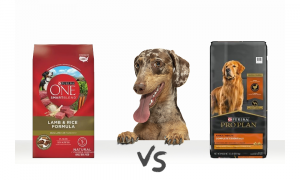Sensitive Stomach? Here Are the Best Dog Food Brands for Your Pup
What We'll Cover
- Best Dry Foods for a Sensitive Dog Stomach
- Diamond CARE Adult Dry Dog Food
- Nulo Limited Ingredient Dry Dog Food – Single Protein Grain Free Recipe Premium Kibble
- Hill’s Science Diet Adult Sensitive Stomach Dry
- Royal Canin Large Digestive Care Dry Dog Food
- A Guide to the Right Dry Dog Food for Sensitive Stomachs
- Best Canned Dog Foods for a Sensitive Stomach
- Hill’s Prescription Diet i/d Digestive Care Wet Dog Food
- Purina Pro Plan Sensitive Stomach Pate Wet Dog Food
- WholeHearted Grain-Free Adult Boiled Chicken Dinner Wet Dog Food
- Nature’s Recipe Easy to Digest Wet Dog Food
- A Guide to the Right Canned Dog Food for Sensitive Stomachs
- Picking a Product That Works With Your Dog’s Sensitive Stomach
- How Did You Find Out About the Issue?
- Is Your Dog Prone to Sensitive Stomach Issues?
- What Are the Typical Causes for Digestive Issues in Dogs?
- Transitioning From Regular Dog Food to a Product Designed for a Sensitive Stomach
- How to Make It Work and Help Your Puppy
Few things are less fun for your pup than digestive issues. If you own a dog that has a sensitive stomach, you’ll need to both understand the underlying issue and find a potential solution.
Often the right solution is in the diet. In this guide, you’ll learn everything you need to know about the best dog foods for a sensitive stomach, both wet (canned) and dry.
Best Dry Foods for a Sensitive Dog Stomach
Dry dog food is practical because it’s easy to store and you can buy more at once. But you still need the right products for your pup, so here are some options:
Diamond CARE Adult Dry Dog Food
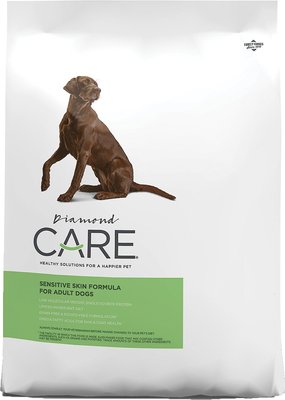
Give your sensitive pooch the complete, holistic nutrition he craves with the Diamond Care Sensitive Skin Formula Adult Limited Ingredient Grain-Free Dry Dog Food. Great for dogs that may have food...
The protein comes from dried eggs, making it highly digestible. It’s also low in fat and comes with relatively few ingredients.
Nulo Limited Ingredient Dry Dog Food – Single Protein Grain Free Recipe Premium Kibble
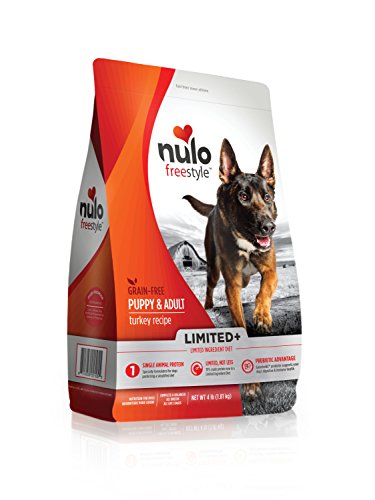
SELECT AN AMOUNT: Bags are available in small 4 pound, medium 10 pound, and large 22 pound sizes
PICK A FORMULA: Our turkey and salmon recipes are sourced with a single protein for pure flavor
ALLE...
It’s single-protein, and its ingredients are limited to minimize allergens. Plus, it includes probiotic support to help with digestion.
Hill’s Science Diet Adult Sensitive Stomach Dry
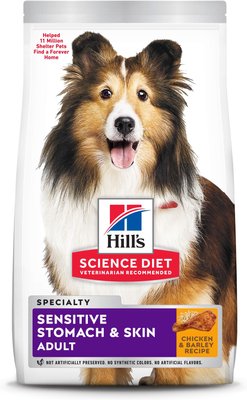
Description
Nourish your furry friend from the inside out with Hill’s Science Diet Adult Sensitive Stomach & Skin Chicken Recipe. This dry dog food is specifically designed for adult dogs. It featu...
This food is designed specifically for sensitive adult dog bellies. A fat-to-protein ratio of 61% is excellent, and it’s high in fiber to help with digestion.
Royal Canin Large Digestive Care Dry Dog Food

Large Digestive Care dry dog food (formerly Maxi Digestive Care) is formulated for large dogs 15 months and older weighing 56-100 lbs. with a sensitive stomach
Promotes healthy digestion with optim...
This has a 5% fat content percentage, making it the lowest on this list. The formula also has prebiotic ingredients to maximize digestion.
A Guide to the Right Dry Dog Food for Sensitive Stomachs
Dry food for your pup comes with a few crucial advantages. It’s less expensive, and you can buy more at once, thanks to large bags that are easily resealable. But even beyond the brand, you need to make sure that you get the product and process just right.
Part of that is the storage solution. If you don’t want to keep it in the bag, make sure you find resealable canisters. Wash or wipe them out each time new food goes in to prevent harmful particles from building up.
Focus on the Right Ingredients
With the help of a vet, you might know what causes adverse reactions in your dog’s belly. Make sure the ingredients of the dry dog food you pick don’t make it worse. That way, you can focus your attention on food that will actually help your puppy.
Simple Is Best
Generally speaking, when it comes to ingredients, less is more. When you compare dog foods for sensitive stomachs with their regular alternatives, you’ll notice that the ingredient list tends to be shorter. You should also make sure that you know exactly what each ingredient means so that you can stay away from vague or misleading claims and supplements.
Get the Right Mix of Ingredients
Generally speaking, you’re looking for four main nutrients in your puppy chow: protein, fiber, fat, and ash. Make sure they’re present, ideally in that order, before you buy the product.
Pay Attention to the Instructions on the Dog Food Packaging
Every bag of dry dog food comes with instructions on the right portions for dogs, generally by weight or size. Follow it closely so you can minimize digestive issues for your dog in the process of changing out their food.
Best Canned Dog Foods for a Sensitive Stomach
Canned food is wetter than dry food because of added ingredients. Whether it’s better than dry food depends entirely on your puppy’s preference.
Hill’s Prescription Diet i/d Digestive Care Wet Dog Food

Hill's Prescription Diet i/d Digestive Care with Turkey Canned Dog Food is a veterinary diet specially formulated by Hill’s nutritionists and veterinarians to support your dog’s digestive health
Th...
Its low fat content is a great start, and the nutrients in the ingredients (which are limited) are specifically designed to ease digestion.
Purina Pro Plan Sensitive Stomach Pate Wet Dog Food
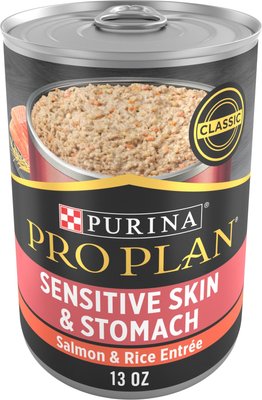
Description
Someone's about to go to the top of their Obedience School class with this brain-building bowl of yum! Purina Pro Plan Select Adult Classic Sensitive Skin & Stomach Salmon & Rice Entree...
Purina is among the best brands for sensitive dog bellies. This product offers high levels of fatty acids and a formula specifically designed for easy digestion.
WholeHearted Grain-Free Adult Boiled Chicken Dinner Wet Dog Food

Grain-Free Adult Boiled Chicken Dinner Wet Dog Food from WholeHearted
Vitamins & Minerals for Balanced Adult Nutrition
Minced in Gravy
No Corn, Soy, Wheat, or Grains of Any Kind
Antioxidant Formula...
This product is formulated without grains, specifically to ease digestion. Your dog’s stomach will also appreciate the healthy mix of vitamins and minerals.
Nature’s Recipe Easy to Digest Wet Dog Food
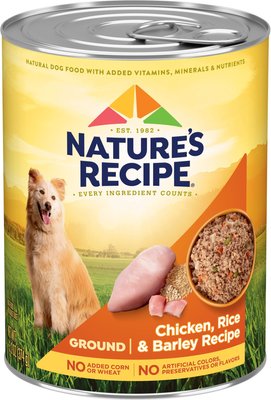
Description
Nature's Recipe Easy-to-Digest Chicken, Rice & Barley Recipe Homestyle Ground is made with all the good stuff a healthy adult dog needs: natural chicken and barley with added antioxidan...
Again, the lack of grains helps with digestion, but this option also shines because of its healthy mix of carbohydrates.
A Guide to the Right Canned Dog Food for Sensitive Stomachs
The best canned dog food is not piecemeal. In one can, it should include all the nutrients, minerals, and vitamins your puppy needs. Otherwise, the diet gets too complicated, leading to potential digestive problems. Also, make sure you only feed the right dosage by following the directions on the can.
Understanding the Reasons Behind Your Dog’s Sensitive Stomach
In the best case scenario, you know exactly what’s ailing your puppy. In that case, you’ll understand what ingredients you need to avoid. Maybe a fatty diet is not a good idea — choose your wet dog food accordingly.
Focus on the Ingredients in the Can
Speaking of ingredients, that label is the most important part of the product when you’re making a decision. Ingredients listed first are present the most, so be sure you know what’s in the tin and how it might affect your puppy’s belly.
Introduce New Foods to Your Dog Slowly
If your dog already has a sensitive stomach, don’t exacerbate it by changing their entire diet all at once. Any change in diet can make those issues worse. Instead, start by keeping the old food in the mix (but at smaller portions), slowly introducing the new food in the process.
Over time, shift the proportions so that eventually, your pup is eating its new wet food. That way, you’ll also be able to tell if the new option actually makes things better or worse.
How to Store Open Cans of Dog Food
If you have a small dog that doesn’t eat a whole tin, or if you’re just introducing the new food, don’t leave parts of it in its original container. Instead, get an airtight canister to store the rest in, ideally in your fridge, to avoid bacteria build-up.
Picking a Product That Works With Your Dog’s Sensitive Stomach

Before you pick a food, you need to chat with your vet. It’s your best way of finding out the underlying cause, which might require treatments that go far beyond the food. However, if there is no major problem, changing up the diet can help.
How Did You Find Out About the Issue?
Most dog owners find out about their dog’s sensitive stomach in one of three ways: their puppy is sick, they have diarrhea, or they pass gas too frequently. If it happens once or twice, that’s OK. But if it becomes a frequent issue, you need to take action.
Take note of what exactly is wrong. That’s important information your vet will want to know. They might be the first to recommend to you what type of dog food can help.
Is Your Dog Prone to Sensitive Stomach Issues?
Some dog breeds are more likely to have a sensitive belly than others. They might just have that problem from birth. Some research can help you find out if your dog is among them, and you’ll find literature about what food is good for that breed. If it develops later in life, there is likely another cause.
What Are the Typical Causes for Digestive Issues in Dogs?
A few of the reasons most likely to cause your dog’s sensitive stomach include:
Specific Protein Sources
Some pups’ bellies are just less likely to agree with a type of protein (like beef) or mixes of protein from multiple sources.
High Fat Content
As with humans, it can lead to digestive issues.
Fiber
A lack of fiber might lead to internal issues in dogs, just as it does for humans.
Low Price
Cheap dog food might have vague or undefined replacements of common ingredients that cost less to produce. But they can harm your dog’s stomach.
Also Avoid Non-Nutritious Treats
It’s easy to overlook the nutrition value (or lack thereof) in puppy treats. Make sure you consider it just as you would regular dog food for your digestive issues.
Transitioning From Regular Dog Food to a Product Designed for a Sensitive Stomach
Whichever food you pick, don’t make the switch immediately. Instead, slowly reduce their food intake on the previous product while you bring the new one into the diet.
How to Make It Work and Help Your Puppy
Seeing your dog feeling unwell is never good. Fortunately, the right dog food for sensitive stomachs can make a world of difference. The variables are plentiful, but this guide can help you find the options that ultimately have the best chance of seeing them back to full health.
The responses below are not provided, commissioned, reviewed, approved, or otherwise endorsed by any financial entity or advertiser. It is not the advertiser’s responsibility to ensure all posts and/or questions are answered.


